Table tennis is the sport for the lightest and smallest ball used in the Tokyo Olympics. So a slight deviation of quality matters heavily for the output results. The search for the best ping pong balls heavily depends upon three factors, i.e. bounce, roundness, and durability. Also, there are many other factors like color, brand preference, and price which depend on personal preference and budget.
The wide variety makes it quite confusing to pick the right one out of 15 or 20 brands. Moreover, it is hard to judge a table tennis ball if you have not experienced it.
In my club, I have tested table tennis balls of many brands and with my experience, I like to share the list of 15 top ping pong balls that can fulfill your needs.
Best Ping Pong Balls: Top Recommendations
JOOLA Training 3-Star Best For Training 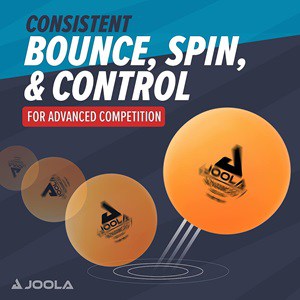 $10.49 (60 Pack)
Best Training | Nittaku Premium40+ Best Competition Ball 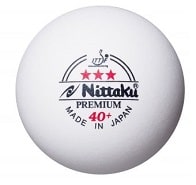 $31.95 (12 Pack)
Best Competition | Kevenz 3-Star Best For Practice 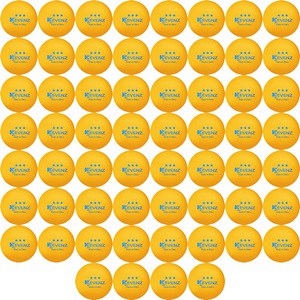 $12.99 (60 Pack)
Best Recreation |
Best Ping Pong Balls: At a Glance
These are the best ping pong balls that can guarantee your satisfaction according to your requirements.
Image | Name | Type | Rating | Store |
 | Nittaku Premium | Competition | ||
 | Butterfly G40+ | Competition | ||
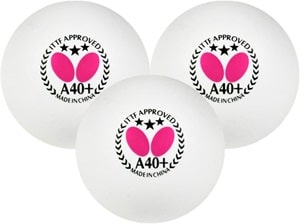 | Butterfly A40+ | Competition | ||
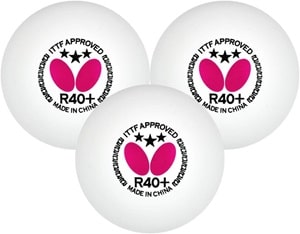 | Butterfly R40+ | Competition | ||
 | Xushaofa Sports 3 Star | Competition | ||
 | STIGA 3 Star | Competition | ||
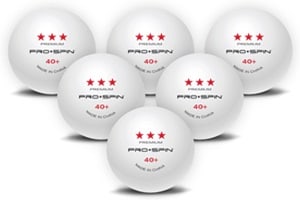 | PRO SPIN Elite | Competition | ||
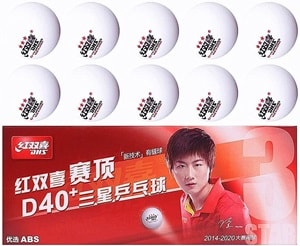 | DHS Dual D40+ | Competition | ||
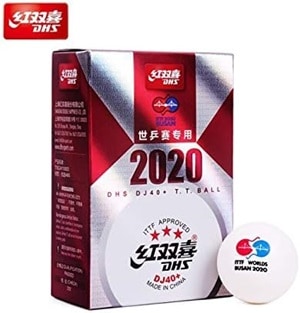 | DHS Dual DJ40+ | Competition | ||
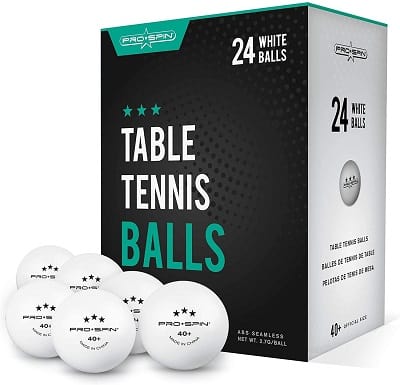 | PRO SPIN Standard | Training | ||
 | Joola Training Ball | Training +Recreation | ||
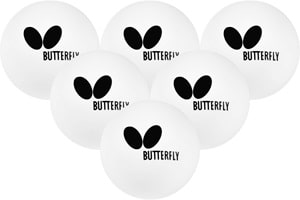 | Butterfly 40mm Easy | Training | ||
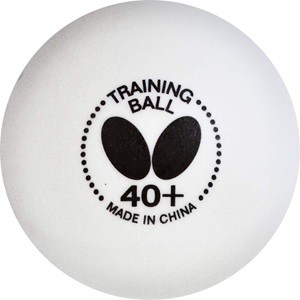 | Butterfly 40+ Training Ball | Training +Recreation | ||
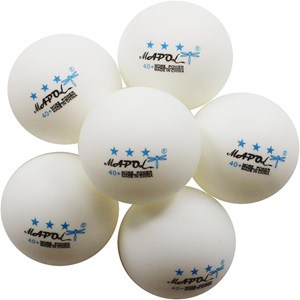 | MAPOL Ping Pong Ball | Training + Recreation | ||
 | KEVENZ Ping Pong Ball | Training + Recreation |
Based on the quality, I have segmented them into three categories, competition, training, and recreation.
Competition balls always need to be precise in terms of bounce and the quality should be on the higher side with enhanced durability.
For training purposes, you need a lot of balls at a time. It is not necessary to opt for the best quality and it is also a legacy to use the highly-priced table tennis balls for training purposes.
For recreation, a decent bounce is enough, but the focus should be more on durability.
What is a Ping Pong Ball?

A ping pong ball is a small, hollow ball used as basic equipment in table tennis. As per the official laws governed by the ITTF (International Table Tennis Federation), it must conform to the following requirements.
- The ball must be made from celluloid or similar plastic material.
- The ball shall be spherical, with a diameter of 40 mm.
- The weight of the ping pong ball shall be 2.7 gm.
- It must be white or orange colored.
- The ball shall have a matte finish.
History of the Ping Pong Balls
From the year 1926 when ITTF governed, the color of the Table Tennis Ball changed several times. Sometimes, it was white or yellow, then white or yellow/orange. In 1997, the color of the ball became white or orange and till now it has continued.
In the year 2000, ITTF made a major change. ITTF set the diameter of the ball to 40 mm instead of 38 mm.
A table tennis ball with a diameter of 38 mm is faster and spins more. The occurrence of the longer rally is more predictable for a ball of 40 mm in diameter. That enhances the enjoyment of spectators and increases the popularity of Table Tennis.
Another major change came in the year 2014 when ITTF switched over from celluloid to plastic as a material for Table Tennis Balls.
With safety awareness growing worldwide, the flammability of celluloid became a risk factor and many countries were also objecting to celluloid.
Acrylonitrile Butadiene Styrene (ABS) is a copolymer, that appeared as a welcome fit by the manufacturers. By mid-2016, these “second-generation balls” conquered the approval list of ITTF. It boosted the durability and roundness of the plastic ball.
Thereafter a flood of new models came in with superior quality. With storage and logistics getting easier because of the lack of flammability and with more competitors on the market, the price of plastic balls went far below celluloid balls.
Though ITTF kept the option of celluloid to run along with plastic, it is very hard to find any celluloid balls in the market at present.
Characteristics of Ping Pong Balls
Based on these vital 6 characteristics, you can select the top ping pong ball according to your needs.
- Appearance
- Material
- Seamed balls or seamless
- Star rating
- Stamping
- Packaging to identify the manufacturing date
Among these, the star rating, the property of seamed or seamless, and the material are the key factors for your section. You should concentrate more on these three factors.
1. Appearance
A ping pong ball must be white or orange. The selection of ball colors depends on the background. For a dark background, the color should be white, while for a white background, it should be orange.
One thing also to remember is the dominant color of a shirt, skirt, or shorts. Other than the sleeves or collar, the color of a shirt must differ from the color of a ball.
2. Material
Though celluloid balls are going to be obsolete, you will still find these balls on the market along with plastic balls. Nowadays, these celluloid balls are not used in competitive tournaments and they are also costlier than plastic balls.
To distinguish between plastic and celluloid balls, check the package for 40 or 40+, If it is 40, then there are celluloid balls inside the package, and for 40+, it is plastic table tennis balls.
3. Seamed or Seamless
In the market, you will find two variations of Table Tennis Balls. One is seamed, and the other one is seamless.
A seamed ball must consist of only one seam as per ITTF guidelines. Plastic balls are either seamed or seamless whereas only seamed balls are available for celluloid.
Advantages of Seamless balls over seamed
- Seamless balls are more durable.
- The generation of spin is more in seamless balls.
- Seamless balls fly in the air comparatively quicker than seamed balls.
- Roundness is superior.
- The bounce is more uniform.
- The feeling is better than seamed balls.
4. Star Rating
Fortunately, you can differentiate Table Tennis Balls with their star rating which will ease your option to choose.
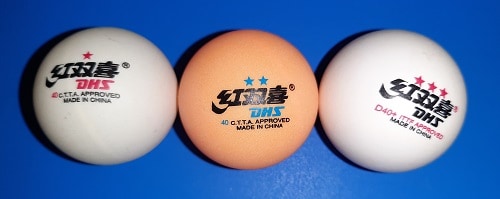
You can see three types of star ratings.
1 Star: It belongs to the lowest quality of the three. If you are a beginner, you may use it for training, but these balls are more prone to damage.
2 Star: These table tennis balls are better than 1 star in terms of quality and durability. Two-star balls are more popular at the school and club levels.
3 Star: It denoted the highest level of quality. Tournament organizers at the international, national, and state levels use 3-star balls.
5. Stamp
The stamp of the ball may cover a maximum area of 280 mm². The stamp on the surface of the ball should contain only the following items.
- ITTF approval (List of ITTF-approved balls for the current year)
- Star rating
- Brand Name
- 40+ for plastic balls and 40 for celluloid balls.
- “Made in” followed by the country of production.
6. Packaging
The ping pong ball must be packaged properly in paper or plastic boxes or a blister pack.
The date code must be visible on all packaging. The date code comprises 4 characters i.e. the first 2 for the month and the last 2 for the year.
Properties of Ping Pong Balls
The following properties of a table tennis ball should match the standards fixed by ITTF (International Table Tennis Federation)
- Weight
- Size or Diameter
- Bounce Conformity
- Spherical Conformity
- Hardness Conformity
- Veer
- Color
1. Weight
The weight must be 2.7 gm with tolerance with an upper limit of 2.77 gm and a lower limit of 2.67 gm. Heavier balls are faster than lighter balls.
2. Size
- For celluloid balls: The maximum limit diameter is 40.50 mm, whereas the minimum diameter must be at least 39.50 mm.
- For non-celluloid balls: The minimum diameter of balls must be at least 40.00 mm and the maximum diameter must be within 40.60 mm.
3. Bounce conformity
- For celluloid balls: Every ball must rebound to a minimum height of 240 mm and a maximum height of 260 mm when dropped from a height of 305 mm on a table tennis table.
- For non-celluloid balls: Every limit is the same as celluloid balls except the limit of maximum height which is 265 mm.
4. Sphericity conformity
Table tennis balls must be spherical. The sphericity of a ball which indicates the lack of sphericity is the absolute difference between the maximum and minimum diameter.
- For celluloid balls: The sphericity of any ball must be less than 0.35 mm.
- For non-celluloid balls: The sphericity must be less than 0.25 mm.
5. Hardness conformity
- For balls with seam: The geometric mean pole hardness of any ball should be between 0.68 and 0.81 mm.
- For seamless balls: It should be within 0.70 to 0.90 mm.
6. Veer
Ping pong balls must not veer. Veer not only measures the roundness but also defines the difference in thickness along the surface of the ball. You can test it by rolling the ball down from a slightly inclined surface. If the path of the ball follows a straight line, it does not veer.
7. Color
The color of every ball must be either white or orange. If the background color is light, it is better to use orange-colored balls whereas, for dark-colored backgrounds, white balls are more suitable to use.
How To Care Ping Pong Balls
- Clean balls with a wet, clean cloth. Don’t use an air dryer for drying balls, instead use a dry, clean cloth.
- Don’t keep balls under direct sunlight.
- Don’t store balls in a bathroom, where there is a lot of moisture.
- Keep the ball away from heat.
- Don’t leave the ball on the floor to avoid stepping.
- Don’t press the ball hard if there is any doubt about any type of crack, rather follow the undermentioned procedures.
How to Confirm if a Ping Pong Ball is Cracked
The doubt comes from the sound during play. To be sure that the ball is cracked, you may follow two things.
- Drop the ping pong ball a couple of times on the table and if you hear a different-pitched sound on the impact, then there is a crack on the surface of the ball.
- For more confirmation, rub the ball with your palm against the surface of the tabletop and if there is a creak, it will be evident quickly.
Best Brands for Ping Pong Balls
In the market, you will find ping pong balls of many reputed companies. But among them, three brands are widely reputed for maintaining quality. Though the price of these balls is on the higher side, they give you the ultimate bounce. These balls are also more durable which justifies the high price.
Nittaku
Nittaku is a Japan-based company reputed for manufacturing table tennis equipment since July 1947. Nittaku premium balls have been evaluated and regarded as one of the best ping pong balls. Nittaku Premium has been used in many international tournaments and is the top choice of many professionals. The credit goes to Nittaku, for the extensive research and superior manufacturing process.
Butterfly
For every table tennis equipment, Butterfly is always the top contender for the best. Hikosuke Tamasu, a famous Japanese table tennis player established this company 50 years ago. Since then, this company has been producing world-class equipment.
Like every piece of equipment, butterfly balls are excellent with an even surface thickness that gives a good and uniform bounce.
STIGA
STIGA Sports, a global Swedish table tennis company started its production in 1944. It is one of the world’s largest brands of table tennis equipment. STIGA has a collection of a wide variety of table tennis balls according to the seriousness of play, competitive, training, or recreational.
Xushaofa Sports
Xushaofa Sports, a Chinese manufacturer, is a specialized brand in the field of table tennis balls. This company produces the balls seamlessly rather than joining the two halves. This technology offers uniform surface thickness for the best results in terms of good bounce and durability.
Frequently Asked Questions
Simply check the stamp as below: All plastic balls carry “40+” on the stamp. All celluloid balls carry “40” on the stamp.
Please check the differences at a glance as shown below.
For all world titles and ITTF-sanctioned events, the plastic ball is the only option.
Organizers of all other international and national events are free to choose any of them.
Check the approval code in the packet for the year of approval
Sample- Approval code
ITTF-165-B-06/16
“40” shows the material of the ball as celluloid and a diameter of 40 mm whereas 40+ is for plastic as a material with marginally increased tolerance in diameter.
Yes. But it’s not huge. This is probably because of the increase in size while maintaining the same weight of 2.7 grams.
There is a misconception regarding the presence of flammable gas inside a ping pong ball. But that’s not right, it’s just normal air.
Reviews of the 15 Best Ping Pong Balls
Now, check the best available in the market which are more durable and give you a better experience in the game in terms of quality of bounce.
- Nittaku Premium 40+ 3 Star (Type: Competition)
- Butterfly G40+ 3 Star (Type: Competition)
- Butterfly A40+ 3 Star (Type: Competition)
- Butterfly R40+ 3 Star (Type: Competition)
- Xushaofa Sports 3 Star (Type: Competition)
- Stiga 3 Star (12 Balls) (Type: Competition)
- Pro Spin Elite (Type: Competition)
- DHS ABS D40+ 3 Star (Type: Competition)
- DHS DJ40+ 3 Star (Type: Competition)
- PRO SPIN Standard (Type: Training )
- JOOLA Training 3 Star (Type: Training + Recreation)
- Butterfly Easy Training Ball (Type: Training)
- Butterfly 40+ Training Ball (Type: Training + Recreation)
- MAPOL 50 3 Star (Type: Training + Recreation)
- Kevenz 3 Star (Type: Training + Recreation)
1. Nittaku Premium 40+ 3-Star Table Tennis Ball
Type: Competition ($2.66/ ball: 12-Pack)

Nittaku Premium 40+ is one of the best non-celluloid plastic balls. Nittaku, a Japan-based company uses special poly material for the production of these balls that offer the ultimate bounce for your best experience.
These quality balls offer better roundness and durability. It is the most superior that I have played so far. When you hit Nittaku Premium, you will get a nice feeling. It is the most preferred for professionals and is also featured as an official ball of the Liebherr 2017 World Table Tennis Championships.
Key Features
- Superior roundness
- Does not wobble
- Extensively tested at the highest levels
- The superior manufacturing process confirms the excellent quality
- ITTF approval makes it legal for all tournaments
Pros
- Excellent playability
- Consistent bounce
- Highly reputable brand
- Superb spin
Cons
- Slightly costly
Recent Update: After extensive use for 2 weeks, one of my Nittaku Premium balls got separated into two halves along its seam. This may be an exceptional minor flaw for such a high-quality ball.
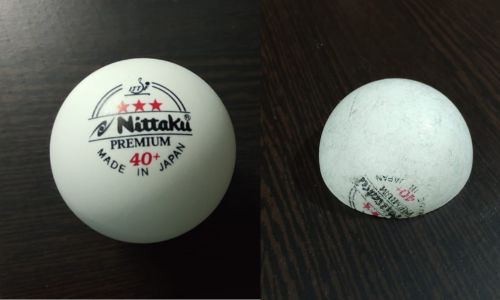
2. Butterfly G40+ 3 Star
Type: Competition (Currently Out of Stock)

The superior quality butterfly G40+ offers great bounce with lots of spins. Though they are expensive, their high durability gives you a good price-performance ratio. Butterfly uses G40+ in their sponsored tournaments in various parts of the world.
Key Features
- Perfect roundness and weight
- Engineered to the highest perfection
- Eye-catching
- ITTF approved
Pros
- Great bounce
- Highly durable
- A perfect blend of high speed and spin
Cons
- Costly
- Availability is an issue
3. Butterfly A40+ 3 Star Ping Pong Balls
Type: Competition

The induction of poly plastic material gives the A40+ balls more durability and uniform bounce than traditional 40 mm celluloid balls. The Butterfly A40+ was the official ball of the 2018 World Table Tennis Championships in Halsted, Sweden.
These balls come in an option of 3 pack, 6 pack, and 12 pack to choose from according to your preference.
Key Feature
- The poly balls remind bounce of celluloid balls.
- The same thickness on all sides creates a very consistent bounce.
- Durable
- Perfect roundness
- Approved by ITTF and USATT
- 3-star ball
Pros
- Top-notch quality
- Highly durability
- Most trusted brand
Cons
- Costly
4. Butterfly R40+ Ping Pong Balls
Type: Competition ($3.00/ ball: 3-Pack)

The Butterfly R40+ is a recently released (2020) new-generation ping pong ball manufactured under strict quality control. This high-standard tournament standard 3-star ball has been used in the World Championship Finals in 2021, which proves its credibility.
Key Features
- Material: Plastic
- 3-star ball
- Quality material
- Perfect roundness and steadiness
- ITTF approved
Pros
- Excellent bounce
- Perfect trajectory
- Great durability
Cons
- Nil
5. Xushaofa Sports Table Tennis Ball
Type: Competition

These excellent balls are the result of Xushaofa’s technological innovation for quality table tennis balls. Xushaofa balls are approved by ITTF and USATT for tournament play.
Key Features
- The use of poly plastic material for more consistent bounce and durability.
- Safer than the traditional celluloid balls
- Perfect roundness and weight
- Excellent quality
- 3 star seamless balls
Pros
- Superb spin
- Excellent playability
- Highly durable
Cons
- High price
6. STIGA 3-Star Ping Pong Balls
Type: Competition ($1.99/ ball: 2 6-Pack)
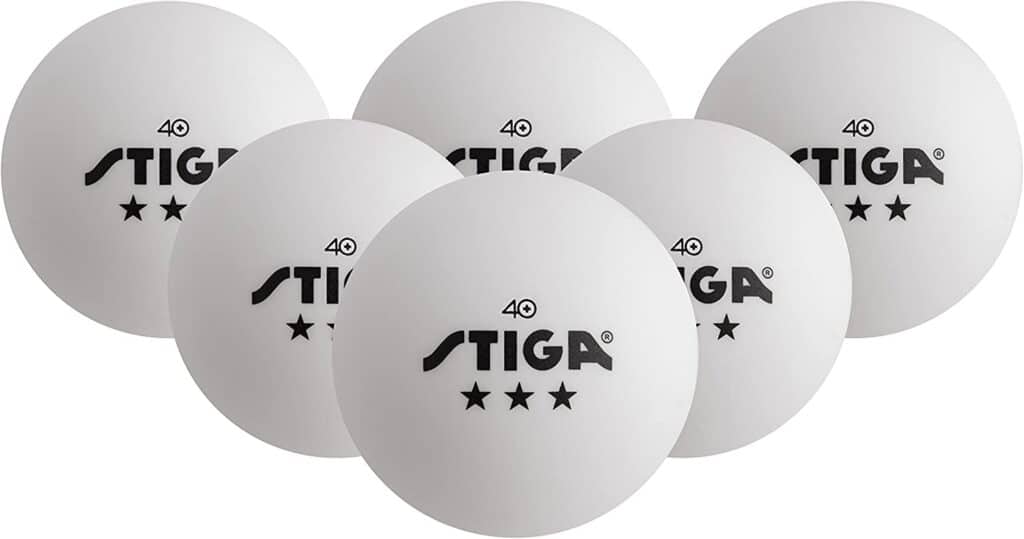
The tournament standard 40 mm plastic balls from STIGA conform to the weight and size as fixed by ITTF. The superior quality of STIGA balls supports consistent bounce, excellent spin, and good control and is approved by USA Table Tennis (USATT).
Key Features
- Material: Plastic
- 3 Star Ball for competition
- Enhanced control
- USATT approved
Pros
- Good bounce and uniformity
- Good visibility
- Highly reputable brand
Cons
- Not for professionals
7. PRO SPIN Elite 3-Star Ping Pong Balls
Type: Competition ($1.50/ ball: 10-Pack)

The Pro Spin Elite balls are designed for superior durability, roundness, and consistency to meet the benchmark of the highest tournament-level quality. Each ball is preciously manufactured and tested manually for perfect sphericity, veer, and true dimensional measurements.
Key Features
- Material: Acrylonitrile Butadiene Styrene (ABS)
- Perfect spherical shape
- No veer
- Competition standard
- Color: White
- Weight: 2.7 grams
Pros
- Superior quality for professional standard
- True consistent bounce for better playability
- Perfect flight and spin without any wobble
- Highly durable
- Value for money
- Prompt customer service
Cons
- Not ITTF approved
8. DHS ABS D40+ 3-Star Ping Pong Balls
Type: Competition ($1.5/ ball: 10-Pack)

DHS, a Shanghai-based company is the largest supplier of table tennis balls in the world and also the official supplier for the World Championship in 2008, 2012, and 2014.
The new type of plastic gives the D40+ balls a good bounce trajectory with enhanced durability. D40+ is the official ball of the world competitions from 2017 to 2020.
The D40+ is ideal for beginners and intermediate players who want to feel the experience of an international competition ball at a low budget.
Key Features
- Seam ball
- Material: ABS
- More accurate sphericity and better elasticity
- Low priced
- ITTF approved
Pros
- Good bounce
- Durable
- Great value for money
Cons
- Not for professionals
9. DHS DJ40+ Table Tennis Ball
Type: Competition ($2.5/ ball: 6-Pack)

The DJ40+ is an improved version of the previous D40+ model with a higher price tag. This tournament standard 3-star ball is made with the same plastic (ABS) material. The DJ40+ was used in the World Table Tennis Championship, Busan, 2020.

In addition to the good playability, the eye-catching logo helps to identify the amount of spin while receiving an opponent’s serve.
Pros
- Good bounce and consistency
- Highly durable
- Value for money
Cons
- Nil
10. PRO SPIN Standard Training Balls
Type: Training ($0.38/ ball: 60-Pack)

If you are searching for quality balls for training that are within a low price bracket, PRO SPIN is a good option. They are 3-star seamless, made with high-grade poly plastic material, to stay away from the use of celluloid. PRO SPIN 3-star balls are perfectly rounded for uniform bounce and are durable. They can handle the attack better while maintaining spin and control.
Key Features
- Material: High-grade ABS plastic
- Seamless construction
- Weight: 2.7 grams
- Affordable
- 1-year quality guarantee
- Approved by USATT (USA Table Tennis) and ITTF (International Table Tennis Federation)
Pros
- Great for recreational play
- Durable
- Highly affordable
Cons
- Not for tournaments
11. JOOLA Training 3 Star Balls
Type: Training + Recreation ($0.17/ ball: 60-Pack)

If you want quality table tennis balls for practice, the 3-star training balls from the renowned brand JOOLA can be very useful.
They are very affordable and can be the perfect choice for practicing serves, multi-ball training, or enjoying ping pong with friends at your home or club in a budget-friendly manner.
Key Features
- Material: Plastic
- Perfectly round
- White or orange color option
- 12 balls pack
Pros
- Good playability
- Excellent for training
- Durable
- Great value for money
Cons
- Issues to use in a robot
12. Butterfly Easy Training Ping Pong Balls

Type: Training ($1.83/ ball: 6-Pack)
The Easy Training table tennis balls are a new addition from Butterfly for casual use at home or school, multi-ball practice, or for use in a robot. They are produced in the same factory which is used for the premium 3-star butterfly balls. The easy training balls are introduced with a very reasonable price range while offering great value to the product.
These balls are far better than the normal poly-plastic balls available in the market. The Easy 40+ is perfectly round, produces good and consistent even bounce, and is also more durable. You have the option to choose between a 6-pack or 120-pack according to your need.
Key Features
- Made with poly plastic material
- 40 mm diameter new balls
- Affordable
- Great for multi-ball practice
- Available in a 6-pack or 120-pack
Pros
- Very good quality
- Durable
- Great for practice
Cons
- Not a 3-star ball
13. Butterfly 40+ Training Ball
Type: Training ($0.64/ ball: 120-Pack)

Butterfly has a brand reputation for maintaining supreme quality without compromising price. But these training balls come at a much-reduced price with the feel of competitive balls. They are not as good as the tournament standard 3-star balls, but they offer enough quality to be used for multiball practice or robots.
Key Features
- Good quality plastic balls
- Great value for money
- Color: White
- Available in 6-pack or 120-pack
Pros
- Uniform bounce
- Durable
- Great for multi-ball practice
Cons
- Slightly pricy
14. MAPOL 50 3 Star Ping Pong Balls
Type: Training + Recreation ($0.24/ ball: 100-Pack)

For training, you need ping pong balls in bulk and for this, MAPOL can be handy for you. It fulfills your requirements in terms of quantity and quality as they have a nice, uniform bounce. MAPOL balls are durable also and surprisingly, they are very low priced concerning the amount of value they give.
Pros
- Great for recreational play
- Value for money
Cons
- Not a well-known brand
15. Kevenz 3 Star Ping Pong Balls
Type: Training + Recreation ($0.22/ ball: 60-Pack)

The lightweight Kevenz balls have good bounce and are durable enough for the enjoyment of the game. They are slightly heavier than the standard weight which is good to use in robots. Also, the outer surface creates the perfect friction for your topspin and backspin shots. Kevenz balls are great for a limited budget and last more than a year to keep the ball rolling.
Pros
- Good quality
- Good feeling
- Great for casual play
- Great for use in robots
- Value for money
Cons
- Not for serious players
My Recommendations
Best Overall for Competition: Nittaku Premium 40+
Best Affordable Competition Ball: DHS ABS D40+
Best for Training: JOOLA Training 3-Star
Best for Recreation: Kevenz 3-Star
Wrapping Up
There are various options for ping pong balls in the market. You may experiment with them and pick up the right one for you. But only the 3-star competition balls give you the best practice if your focus is to play in competitive tournaments.
